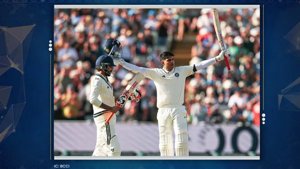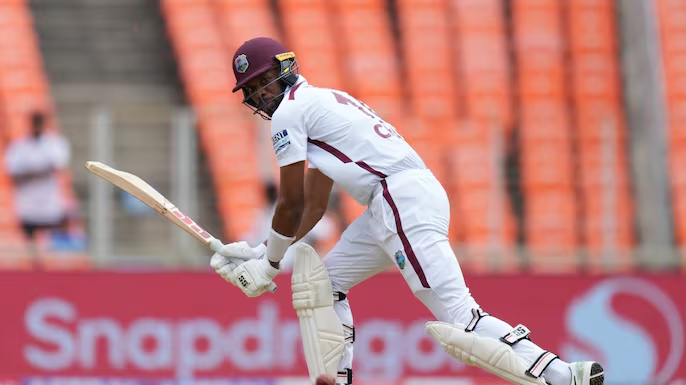west indies vs india In the ongoing 1st Test match between West Indies and India on Day 1 at Narendra Modi Stadium, Ahmedabad, Kuldeep Yadav took a crucial wicket by cleaning up Shai Hope. West Indies are currently 5 wickets down against India’s bowling attack. Mohammed Siraj has been very effective as well, taking multiple wickets, including the fall of Roston Chase. The West Indies team is struggling to build partnerships, with their lower order looking to stabilize the innings. At this stage, West Indies are around 105/6 in 27 overs while Justin Greaves and Roston Chase are at the crease trying to hold the innings together. India is firmly in control of the match, applying pressure with their disciplined bowling and field placements
India and West Indies are currently playing a Test cricket series in India in October 2025. The series consists of two matches, with the first Test held at the Narendra Modi Stadium in Ahmedabad. On Day 1 of the first Test, West Indies opted to bat after winning the toss but struggled against India’s bowling attack. By lunch on Day 1, West Indies were at 90/5, with Mohammed Siraj and Jasprit Bumrah leading the bowling charge. Siraj has been particularly effective, taking multiple wickets. India is playing with three spinners and has shown dominance in the early session of the match. This series is part of the World Test Championship 2025-27 cycle, where both teams are eager to earn points. West Indies face challenges due to injuries in their pace attack, while India is looking for redemption on home soil after a strong recent performance in England.
If more details about the match status or further updates about the series are needed, that information can be provided as well.
IND v WI, 1st Test: Shubman Gill’s India aim to reignite home dominance

India captain Shubman Gill is leading the team in his first home Test series as captain against West Indies in October 2025. Gill has adopted a bold approach by naming three spinners and two pacers in the playing XI for the 1st Test at Ahmedabad. Despite losing the toss and West Indies opting to bat first, Gill is confident about India’s chances, emphasizing playing “hard and grinding cricket” on the home pitches. He highlighted the team’s preparation and mindset going into the series with a focus on exploiting both seam and spin-friendly conditions to maintain India’s home dominance. This series marks a new era for India under Gill’s leadership after the retirements of senior players like R Ashwin, Virat Kohli, and Rohit Sharma. India aims to win all four home Tests scheduled before the year-end and show strong performance in the World Test Championship cycle.
How did India’s spinners perform in the morning session
In the morning session of the 1st Test between India and West Indies, India’s spinners played an important role in maintaining pressure and taking wickets. Kuldeep Yadav made a strong impact by cleaning up Shai Hope with a perfectly flighted delivery that turned back to hit off-stump. Ravindra Jadeja also bowled with great accuracy, varying his flight and pace, which forced the West Indies batsmen to adopt a very defensive approach, giving away very few scoring opportunities. The spinners complemented the successful pace bowling by Mohammed Siraj and Jasprit Bumrah, helping India dominate the middle overs by keeping the scoring rate low and consistently challenging the West Indies batsmen. By lunch, India had taken five wickets, with the spinners playing a key part in controlling the game and keeping West Indies under pressure at 90/5.
Which specific deliveries from Kuldeep troubled the batters
Kuldeep Yadav troubled batters with specific types of deliveries that combined flight, drift, and sharp turn. His key deliveries included:
- Perfectly flighted balls that dipped sharply, deceiving batsmen in the air with loop and drift, making them miss the length or poke uncertain shots.
- His left-arm wrist spin often brought the ball back into right-handed batsmen, challenging their technique and forcing mistakes.
- The “wrong’un” or googly, which is disguised to look like a standard leg spin but spins the other way, troubled batsmen expecting conventional spin.
- Kuldeep also bowled with precision on length, mixing slower deliveries with quicker ones that skidded through without losing pace, giving the batsmen less time to adjust post-pitch.
- The variation in pace and flight disrupted batsmen’s timing, leading to errors such as inside edges or misjudged sweeps.
These deliveries were instrumental in creating uncertainty among batters, compelling them to play defensive shots or attempt risky strokes that led to their dismissals.Kuldeep Yadav troubled batters with deliveries that combined flight, drift, and sharp turn. He used perfectly flighted balls that dipped sharply and looped in the air, deceiving batsmen and forcing them into mistakes. His left-arm wrist spin brought the ball back into right-handed batsmen, challenging their technique. Kuldeep also effectively bowled his “wrong’un” or googly, which spins the opposite way to normal leg spin and was hard for batsmen to pick. Additionally, he mixed slower deliveries with ones that skidded through quickly, reducing the batsmen’s reaction time and creating uncertainty in their shot selection. These variations and precision in length pressured the batters and led to key wickets, including cleaning up Shai Hope in the recent match.
IND v WI, 1st Test: Shubman Gill’s India aim to reignite home dominance

Shubman Gill’s India aims to reignite their home dominance in the ongoing Test series against West Indies. This is Gill’s first series as India’s Test captain on home soil. He made bold selection decisions for the 1st Test in Ahmedabad, including naming three spinners—Ravindra Jadeja, Kuldeep Yadav, and Washington Sundar—and two pacers—Jasprit Bumrah and Mohammed Siraj—along with all-rounder Nitish Kumar Reddy. Gill emphasized playing hard and grinding cricket, aiming to utilize the spin-friendly conditions often encountered at home. Despite losing the toss, Gill remains confident in his team’s ability to win all four home Tests scheduled before the year-end. The series is important for India to regain their home invincibility, which was broken in their last home series against New Zealand. Many senior players have retired, so this marks the start of a new era with young talent and new leadership under Gill.
How did Shubman Gill set the field when spinners bowled
Shubman Gill sets the field very thoughtfully when spinners bowl, focusing on controlling the scoring areas and creating pressure on the batsmen. He typically places close-in fielders such as slip, short leg, or silly point to capitalize on any chances created by the spin, especially when the ball is turning sharply or the batsmen play aggressively. Gill’s strategy often involves attacking fields to force mistakes, with fields set to cut off easy singles and force batsmen to take risks in trying to score boundaries.
He also adapts the field based on the pitch conditions and the batsmen’s tendencies, sometimes bringing fielders in the circle to stop quick singles or spreading them out in the outfield when the batsmen look to rotate strike more. When Kuldeep Yadav bowls, known for flight and drift, Gill uses close catchers and slips effectively, knowing the deception from the spinner may lead batsmen to edges or mistimed shots. Overall, Gill’s field settings for spinners reflect his proactive captaincy style, aiming to maintain pressure and create wicket-taking opportunities.
What field positions Gill favored against left-arm spinners
Against left-arm spinners, Shubman Gill tends to favor field placements that support attacking leg spin and left-arm wrist spin strategies. He typically sets close catchers such as a slip and a short leg to capitalize on any edges or defensive mistakes. He also places backward point and cover to cut off drives and square cuts, along with mid-off and mid-on fielders to stop straight drives and singles. Additionally, he uses a deep extra cover or deep square leg in the outfield for boundary protection. This setup aims to keep the pressure on batsmen by restricting easy singles and encouraging risky shots that may lead to wickets. Close-in fielders like slip and short leg are especially important when Kuldeep Yadav bowls, as his flight and turn induce edges and mistakes.
Which left-arm spinners troubled Gill most and why
Shubman Gill has been troubled most by left-arm spinners like New Zealand’s Mitchell Santner and South Africa’s Keshav Maharaj. Santner troubled Gill with his consistency, sharp turn, and smart variations, including well-disguised arm balls and variations in pace that confused Gill and led to dismissals. Santner’s ability to maintain pace while getting the ball to turn sharply off the pitch was especially challenging for Gill. Maharaj troubled him with deliveries that spun heavily, often causing Gill to misjudge and get caught on the edge.
Gill’s difficulties with left-arm spin arise because these bowlers exploit the angle of delivery, use flight and drift to create uncertainties, and bowl to the rough outside a right-hander’s leg stump, making it difficult to decide whether to play or leave. The left-arm angle and variations have made Gill susceptible to inside edges and misjudged shots. This is a common challenge for many Indian batsmen against left-arm spin, as reflected in the struggles of other key players against similar bowlers.

